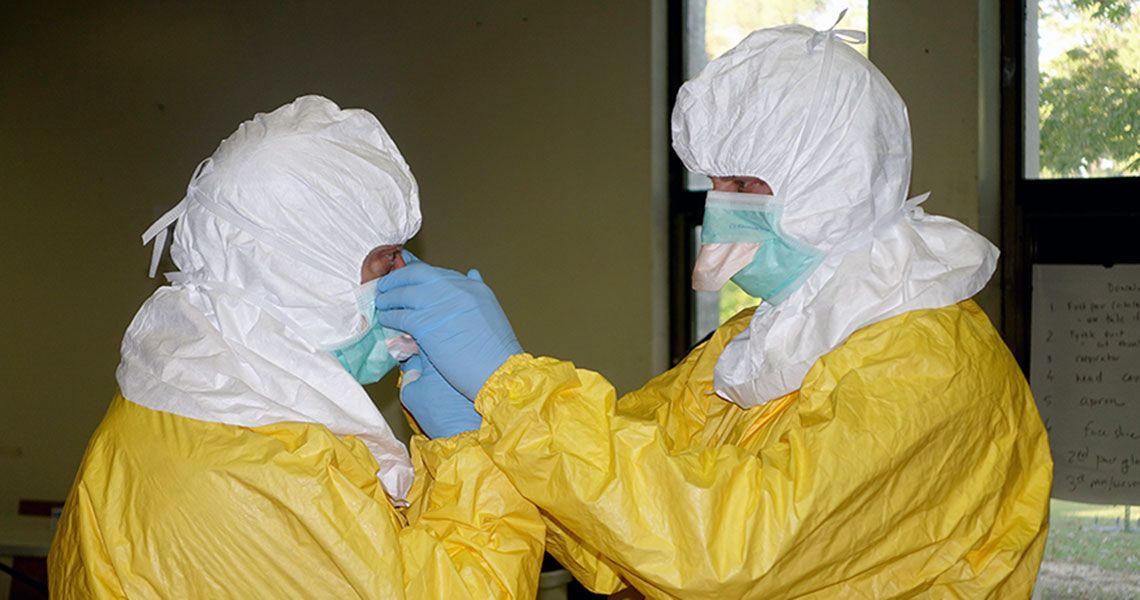The requirements are strict: the isolation gown must cover the entire body; the mask or respirator must be snug to the face and chin; the goggles and hood must be securely in place; and the thick gloves must be pulled down over the wrists. Not a single strip of skin can remain exposed once the Personal Protective Equipment (PPE) is in place. Only then can health care workers enter the simple structures — wood frames, ceilings of tarp or plastic, no air conditioning — of the Ebola Treatment Units (ETU) in Liberia, Africa.
“Communication is very difficult because you have on this big heavy mask, and oftentimes you’re screaming through to have the patient understand you,” says Colleen Kovach, M.D., clinical instructor of emergency medicine at the GW School of Medicine and Health Sciences (SMHS). “You do what you can do, and you don’t necessarily have that time to communicate with patients the way you would normally if, say, you were in a clinic or your office or the emergency department.”
Kovach, who volunteered with a non-governmental organization in Liberia from November to early December 2014, donned and doffed her PPE for intervals of 90-minute or less, just enough time to pass through the ETU and assess whether her patients’ conditions had changed; they could easily slip between surviving and succumbing to the disease.
Death was rampant in the makeshift clinics. “It was my second or third day actually going into the treatment center,” Kovach recalls. “I went in with one other physician, and she had me start at the back of the confirmed unit and go up to do a quick check to see how everyone was doing. I noticed this child was in fetal position — he was 7 years old — and I went to go check on him, and he was cold. He was cold, and he had no pulse, and he had passed probably hours ago. His mom was in the bed next to him. She looked at me, she understood and just rolled over.”
The cemetery outside the ETU, Kovach added, had four to six graves ready at all times. “Sometimes there would be that many patients passing in a day.”
While Kovach was witness to the struggle endured by Liberians infected with Ebola, two SMHS alumni, Brian Burt, PA-C ’03, B.A. ’96, and Mark McKinnon, PA-C ’03, deployed with the United States Public Health Service (USPHS) Commissioned Corps in late 2014 to assist with international health care workers battling the disease.
“This was a unique deployment,” Burt explains. “[USPHS] identified the people that they wanted to go and then gave them the opportunity to say no.”
Burt said yes. He left with USPHS Team One, the first to fly out to Monrovia; their mission was to open an ETU for international patients, but unexpected challenges — flooding, traveler’s diarrhea — delayed progress. Once the ETU was clear to accept patients, Burt, like Kovach, donned his PPE to treat his peers.
“They’re just health care providers like me,” Burt says. “They’re just taking care of Ebola patients, a mistake was made, and they got Ebola, and now they’re dead.”
Needle-stick injuries, Burt explains, carry a high likelihood of infection with Ebola-positive patients, and since treatments tend to include an IV, injuries are not uncommon. “One stick, and you’re done,” he adds.
McKinnon, who deployed to Monrovia with USPHS Team Two, likewise experienced treating both his peers and members of the same family. One patient, Stephen, was a health care worker who delayed treatment, “not only because of the stigma, but because he was scared,” McKinnon says. “By the time we got him to the ETU, he had progressed so far that there wasn’t a lot we could do for him.” Stephen’s brother, Elijah, came to the ETU to attend to Stephen’s burial; a few weeks later Stephen and Elijah’s sister, a health care worker, also contracted Ebola, possibly from caring for Stephen early on. Like dominoes, Elijah eventually sought treatment for Ebola as well, and later died.
“Stephen was a difficult death,” McKinnon says. “Elijah was just extremely difficult because we had tried so hard to help him and get him to survive the disease, but unfortunately he succumbed to it.”
As difficult as the deaths were, the three say, watching patients survive was an unbelievable thrill. Each ETU had its own survivor ceremony; at one ETU McKinnon visited, survivors signed colorful ribbons and tied them to a tree. At the USPHS ETU, survivors slapped yellow painted hands to a blue wall. “That was the most memorable, meaningful aspect [of survival],” Burt says.
On their return home, Kovach, Burt, and McKinnon were either quarantined or kept under active monitoring for 21 days and had to check in regularly. Despite the isolation and lack of a warm homecoming, the three weren’t deterred from returning to high-risk areas. Kovach, for example, is planning a trip to the Turkish-Syrian border this summer. “I love the humanitarian response,” she says. “I’m hoping to make a career out of it. We’ll see where I end up later this year.”



